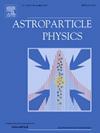Towards searching for photons with energies beyond the PeV range from galactic PeVatrons
IF 2.9
3区 物理与天体物理
Q1 ASTRONOMY & ASTROPHYSICS
引用次数: 0
Abstract
Several gamma-ray observatories have discovered photons of cosmic origin with energies in the PeV () range. Photons at these energies might be produced as by-products from particle acceleration in so-called PeVatrons, which are widely assumed to be the sources of a large part of galactic cosmic rays. Based on recent measurements of these PeV -sources by LHAASO and HAWC, we extrapolate the energy spectra of selected sources up to the ultra-high-energy (UHE, ) regime. The goal of this study is to evaluate if (and under what conditions) giant air-shower observatories, for example the Pierre Auger Observatory, could contribute to testing the UHE luminosity of PeV -sources. Possible propagation effects are investigated as well as the required discrimination power to distinguish photon- and hadron-initiated air showers. For present detector setups, it turns out to be challenging to achieve the required sensitivity due to the energy threshold being too high or the detection area too small. Dedicated detector concepts appear to be needed to explore the UHE frontier. Ultimately, this could provide complementary information on the sources of cosmic rays beyond the PeV regime—a key objective of current efforts in multimessenger astronomy.
从星系pevatron中寻找能量超过PeV范围的光子
几个伽玛射线天文台已经发现了能量在PeV (1015eV)范围内的宇宙起源光子。这些能量的光子可能是所谓的pevatron中粒子加速的副产品,它被广泛认为是大部分银河系宇宙射线的来源。根据LHAASO和HAWC最近对这些PeV γ-源的测量,我们推断了选定源的能谱直至超高能量(UHE,≥10PeV)。这项研究的目的是评估是否(以及在什么条件下)巨大的气淋观测站,例如皮埃尔·奥格天文台,可以帮助测试PeV γ源的UHE亮度。研究了可能的传播效应以及区分光子和强子引发的空气阵雨所需的识别能力。对于目前的探测器设置,由于能量阈值过高或检测区域太小,要达到所需的灵敏度是具有挑战性的。似乎需要专门的探测器概念来探索UHE的前沿。最终,这将为超越PeV范围的宇宙射线来源提供补充信息——这是当前多信使天文学努力的关键目标。
本文章由计算机程序翻译,如有差异,请以英文原文为准。
求助全文
约1分钟内获得全文
求助全文
来源期刊

Astroparticle Physics
地学天文-天文与天体物理
CiteScore
8.00
自引率
2.90%
发文量
41
审稿时长
79 days
期刊介绍:
Astroparticle Physics publishes experimental and theoretical research papers in the interacting fields of Cosmic Ray Physics, Astronomy and Astrophysics, Cosmology and Particle Physics focusing on new developments in the following areas: High-energy cosmic-ray physics and astrophysics; Particle cosmology; Particle astrophysics; Related astrophysics: supernova, AGN, cosmic abundances, dark matter etc.; Gravitational waves; High-energy, VHE and UHE gamma-ray astronomy; High- and low-energy neutrino astronomy; Instrumentation and detector developments related to the above-mentioned fields.
 求助内容:
求助内容: 应助结果提醒方式:
应助结果提醒方式:


